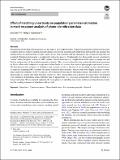Files in this item
Effect of matching uncertainty on population parameter estimation in mark-recapture analysis of photo-identification data
Item metadata
| dc.contributor.author | Ashe, Erin Elizabeth | |
| dc.contributor.author | Hammond, Philip Steven | |
| dc.date.accessioned | 2022-05-23T10:30:01Z | |
| dc.date.available | 2022-05-23T10:30:01Z | |
| dc.date.issued | 2022-05-13 | |
| dc.identifier | 278369849 | |
| dc.identifier | 32f1253c-9576-479e-8647-bb20505b79f9 | |
| dc.identifier | 000795181100001 | |
| dc.identifier | 85132548221 | |
| dc.identifier.citation | Ashe , E E & Hammond , P S 2022 , ' Effect of matching uncertainty on population parameter estimation in mark-recapture analysis of photo-identification data ' , Mammalian Biology , vol. Online First . https://doi.org/10.1007/s42991-022-00236-4 | en |
| dc.identifier.issn | 1616-5047 | |
| dc.identifier.other | ORCID: /0000-0002-2381-8302/work/113060868 | |
| dc.identifier.uri | https://hdl.handle.net/10023/25429 | |
| dc.description | Thanks also to the SeaDoc Society, Molly and John Bailey, the Richardson family, Sarah Haney (Canadian Whale Institute), National Geographic, and Beto Bedolfe at the Marisla Foundation for financial support over the years, and to The Willow Grove Foundation for supporting the Knight Inlet expedition that made 2010 so productive. Erin thanks Air Canada’s Aeroplan Beyond Miles program for travel support. Erin was a beneficiary of a writing retreat for women in science supported by Lyda Hill Philanthropies and the National Geographic Explorers Program. | en |
| dc.description.abstract | Quantifying and dealing with uncertainty are key aspects of ecological studies. Population parameter estimation from mark-recapture analyses of photo-identification data hinges on correctly matching individuals from photographs and assumes that identifications are detected with certainty, marks are not lost over time, and that individuals are recognised when they are resighted. Matching photographs is an inherently subjective process. Traditionally, two photographs are not considered a “match” unless the photo reviewer is 100% certain. This decision may carry implications with respect to sample size and the bias and precision of the resultant parameter estimates. Here, we present results from a photo-identification experiment on Pacific white-sided dolphins to assign one of three levels of certainty that a pair of photographs represented a match. We then illustrate how estimates of abundance and survival varied as a function of the matching certainty threshold used. As expected, requiring 100% certainty of a match resulted in fewer matches, which in turn led to higher estimates of abundance and lower estimates of survival than if a lower threshold were used to determine a match. The tradition to score two photographs as a match only when the photo reviewer is 100% certain stems from a desire to be conservative, but potential over-estimation of abundance means that there may be applications (e.g., assessing sustainability of bycatch) in which it is not precautionary. We recommend exploring the consequences of matching uncertainty and incorporating that uncertainty into the resulting estimates of abundance and survival. | |
| dc.format.extent | 12 | |
| dc.format.extent | 1846159 | |
| dc.language.iso | eng | |
| dc.relation.ispartof | Mammalian Biology | en |
| dc.subject | Abundance | en |
| dc.subject | Capture-recapture | en |
| dc.subject | Photo-identification | en |
| dc.subject | Precautionary principle | en |
| dc.subject | Survival | en |
| dc.subject | GC Oceanography | en |
| dc.subject | QH301 Biology | en |
| dc.subject | NDAS | en |
| dc.subject.lcc | GC | en |
| dc.subject.lcc | QH301 | en |
| dc.title | Effect of matching uncertainty on population parameter estimation in mark-recapture analysis of photo-identification data | en |
| dc.type | Journal article | en |
| dc.contributor.institution | University of St Andrews. Sea Mammal Research Unit | en |
| dc.contributor.institution | University of St Andrews. Marine Alliance for Science & Technology Scotland | en |
| dc.contributor.institution | University of St Andrews. Scottish Oceans Institute | en |
| dc.contributor.institution | University of St Andrews. Centre for Research into Ecological & Environmental Modelling | en |
| dc.contributor.institution | University of St Andrews. School of Biology | en |
| dc.identifier.doi | https://doi.org/10.1007/s42991-022-00236-4 | |
| dc.description.status | Peer reviewed | en |
This item appears in the following Collection(s)
Items in the St Andrews Research Repository are protected by copyright, with all rights reserved, unless otherwise indicated.

